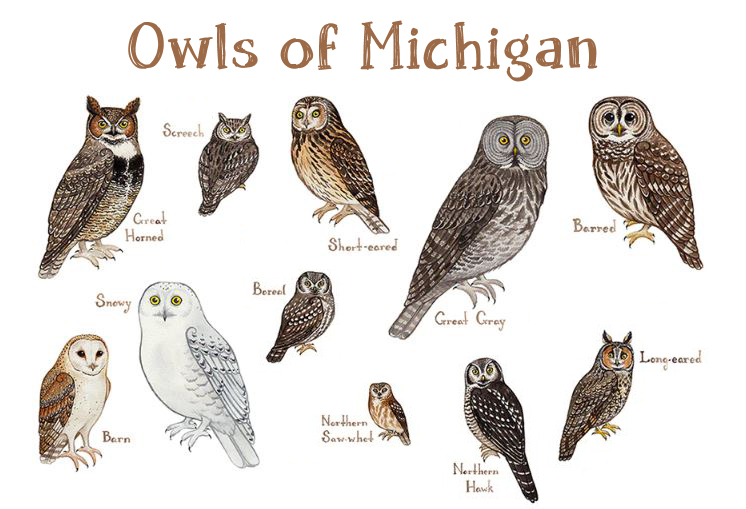
Owls of Michigan
Michigan, with more than half of the state forested, is home to eleven species of owls. Spotting owls can be tricky since most species are inactive during the day. And owls, by nature, are shy and elusive creatures.
Here are some tips for successful owling:
- Learn – Find out about the species of owls in the area you are looking for.
- Listen – Familiarize yourself with the calls of different owls you can come across and listen actively. You are more likely to hear them before seeing them.
- Look carefully – Owls have excellent camouflage, and their plumages are adapted to blend into the night.
- Signs – Also look out for their pellets which are oblong or spherical and brown or grey in color. A large number of pellets indicates a nearby nesting or roosting owl.
- Be respectful – Be still and silent, and refrain from using bright lights, so as not to disturb or frighten them away.
This cache is one of twelve that were published for the 2022 Autumn in Oakwoods event. Each cache will focus on one of the owls that you will find in the state, many of which can be found right here in Oakwoods. A link to all 12 of the caches may be found HERE.
Snowy Owl

- Scientific name – Bubo scandiacus
- Lifespan – 10 (average) 23 years (oldest recorded)
- Size – 20 – 28 in
- Weight – 56 -104 oz
- Wingspan – 50 – 57 in
- Status – Vulnerable
With its striking white plumage and bright yellow eyes, the snowy owl is one of the most unmistakable owls in the world. Although mostly white, the plumage is stippled with dark spots on the upperparts. Females are more spotted and have faint brown barring. Snowy owls have relatively small heads, short ear-tufts, and long feathering. They are perfectly camouflaged against the snowy arctic environment and often appear as a lump of snow on the ground.
Snowy owls are raptors of the Arctic tundra, where they inhabit open treeless environments. They nest in shallow scrapes on dry ground, often on elevated sites such as ridges, hummocks, hills, and outcrops. Snowy owls are nomadic birds with unpredictable migration patterns. During some winters, they erupt south, which is when you will have a chance to spot them in Michigan in meadows, prairies, grasslands, lakeshores, and coastal habitats. They can also be found in crop fields, golf courses, and airport fields.
Unlike other owls, snowy owls have a far-carrying barking call instead of the typical hooting. The common call is a series of hoarse kru kru kru notes. Other vocalizations include clucking, squealing, grunting, hissing, and cackling.
Another unique characteristic of the snowy owl is their hunting activity, which unlike other owls can be during the day or night. They also lack the acute hearing typical of owls, so they rely mostly on their keen eyesight. They hunt from a perch or rise and swoop down on their prey on the ground. The main targets are small mammals, specifically lemmings. They also take other rodents, birds, and on occasion, the odd fish, amphibian or invertebrate.
Due to their erratic nature and the remoteness of their breeding habitat, it is difficult to keep track of the population dynamics of this species. They have few predators and a wide, relatively undisturbed breeding range. But it is estimated that the number of snowy owls has declined drastically. Possible threats include climate change which impacts their habitat and prey availability. During migrations and in winter, they are also prone to collision with cars, powerlines, and fences. They are currently listed as vulnerable by the IUCN. Source: https://avibirds.com/owls-of-michigan/
The Cache: The cache is a medium-sized lock & lock hidden along the river trail.
| This cache is located within Oakwoods Metropark, a part of the Huron-Clinton Metropolitan Authority park system. A Metropark Vehicle Entry Permit is required: Annual Permit $40. Senior(62+) Permit $29. Daily Permit $10.
For general information please call 810-227-2752 or 800-47-PARKS. Or visit our website at www.metroparks.com.
All park rules and regulations apply. Park in parking lots only. Check the Metroparks website for park hours.
|
The permit for this cache has been submitted and approved by the Southern District Interpretive Services Supervisor of the Huron-Clinton Metroparks